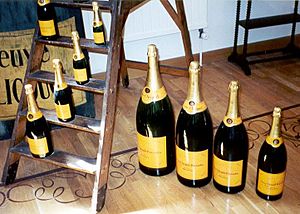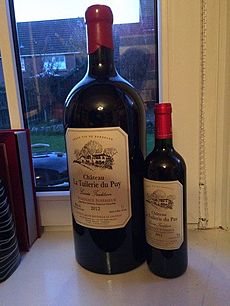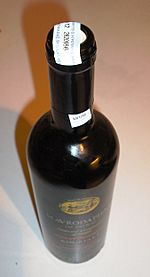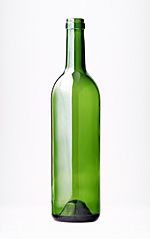Wine bottle facts for kids
A wine bottle is a special kind of bottle, usually made of glass, that is used to hold wine. Some wines are made right inside the bottle, while others are put into bottles after they are finished.
Most wine bottles hold about 750 millilitres (26.40 imp fl oz; 25.36 US fl oz) of wine. This size has become a standard for selling wine around the world. However, wine bottles come in many different sizes and shapes!
Wine bottles are traditionally sealed with a cork. But today, screw-top caps are becoming very popular. There are also other ways to seal a bottle.
Contents
Bottle Sizes
Many traditional wine bottle sizes are named after famous Biblical kings and historical figures. The standard bottle holds 0.75 litres (0.20 US gal; 0.16 imp gal).
Some sparkling wines, like Champagne, are hard to make in very large bottles. This is because it's difficult to turn and shake the big, heavy bottles during the process. Sometimes, Champagne has to be moved from smaller bottles into bigger ones. This can make the Champagne lose some of its fizz.
| Volume (litres) | Ratio | Name | Notes | Champagne | Bordeaux | Burgundy |
|---|---|---|---|---|---|---|
| 0.1875 | 0.25 | Piccolo | "Small" in Italian. Also called a "quarter bottle" or "split". | Yes | ||
| 0.375 | 0.5 | Demi | "Half" in French. Also known as a "half bottle". | Yes "half" | Yes | Yes |
| 0.750 | 1 | Standard | This is the most common size. | Yes | Yes | Yes |
| 1.5 | 2 | Magnum | This bottle holds two standard bottles. | Yes | Yes | Yes |
| 3.0 | 4 | Double Magnum | Holds four standard bottles. | Yes | Yes | Yes |
| 3.0 | 4 | Jeroboam | Named after the first king of Northern Kingdom in the Bible. | Yes | Yes | Yes |
| 4.5 | 6 | Yes | ||||
| 4.5 | 6 | Rehoboam | Named after the first king of separate Judea in the Bible. | Yes | Yes | |
| 6.0 | 8 | Imperial | Holds eight standard bottles. | Yes | ||
| 6.0 | 8 | Methuselah | Named after the oldest man in the Bible. | Yes | Yes | |
| 9.0 | 12 | Salmanazar | Named after an Assyrian king in the Bible. | Yes | Yes | Yes |
| 12.0 | 16 | Balthazar | Named after one of the three Wise Men. | Yes | Yes | Yes |
| 15.0 | 20 | Nebuchadnezzar | Named after a famous King of Babylon in the Bible. | Yes | Yes | Yes |
| 18.0 | 24 | Melchior | Named after one of the three Wise Men. | Yes | Yes | Yes |
| 20.0 | 26 | Solomon | Named after a famous King of Israel. | Yes | ||
| 27.0 | 36 | Primat or Goliath | Goliath was a giant killed by David in the Bible. | Yes | Yes | |
| 30.0 | 40 | Melchizedek or Midas | Melchizedek was a king in the Bible. Midas was a mythical king in Greek stories. | Yes |
Bottle Shapes
Wine makers in different countries like Portugal, Italy, Spain, France, and Germany often use traditional bottle shapes for their wines.
Here are some common bottle shapes:
- Bordeaux bottles: These are straight-sided with high "shoulders" (where the bottle curves inward). They often have a deep dent at the bottom.
- Burgundy bottles: These are tall bottles with sloping shoulders and a smaller dent at the bottom.
- Rhine/Mosel bottles: These are narrow and tall with very little or no dent at the bottom.
- Champagne bottles: These are thick and wide with a deep dent and sloping shoulders. They are built strong to hold the pressure of sparkling wine.
- Bocksbeutel: This is a flat, round bottle used for wines from Franconia in Germany.
- Fiasco: This is a round-bottomed flask wrapped in a straw basket, traditionally used for Chianti wine from Italy.
Many wine makers outside of Europe choose bottle shapes that remind people of famous wines. For example, if a wine is similar to a Burgundy wine, it might be put in a Burgundy-style bottle.
Some companies use unique bottle styles to stand out. For example, Garçon Wines makes a flat wine bottle from recycled plastic. It's thin enough to fit through a letterbox, so it can be delivered by mail!
If you make wine at home, the bottle's shape doesn't change the taste. But for sparkling wines, you need strong, thick bottles to handle the pressure.
Most wine bottles have a neck opening of about 18.5 millimeters (about 0.7 inches) wide.
Bottle Colors
The color of wine bottles traditionally helped protect certain wines from sunlight. This helped the wines age properly. Over time, different regions started using specific glass colors that became linked to their wines. These are not strict rules, and you can find many different colors today.
Some examples of traditional bottle colors include:
- Green for wines from Mosel or Champagne, or Rieslings.
- Darker green glass for Bordeaux wines.
- A lighter "dead leaf" green for Burgundy Chardonnays.
- Clearer bottles are often used for wines that are meant to be enjoyed young and not aged for a long time.
- Amber (brownish) bottles are more common for white wines.
Foils and Netting
Most wine bottles with corks have a protective sleeve called a foil (or "capsule") over the top. This foil helps protect the cork from tiny animals or insects. It also catches small drips when you pour the wine. The foil also adds to the bottle's look.
In the past, foils were made of lead. But it was found that tiny bits of lead could get onto the bottle's lip and mix with the wine. So, lead foils were stopped. Today, most foils are made of tin, plastic, or aluminium.
Sometimes, bottles are sealed with wax, or they might not have a foil at all. In the US, lead foils on wine bottles were officially banned in 1996.
Some special wine bottles have a paper strip under the foil. This is a seal to show the bottle is real. You have to break it to open the bottle. Some high-quality Rioja wines from Spain even have a gold wire netting over them. This netting was invented long ago to stop people from refilling bottles with fake wine, because you couldn't remove the netting without breaking it. Today, the wire netting is mostly for decoration.
Punts (The Dent at the Bottom)
A punt, also called a kick-up, is the dent or dimple at the bottom of a wine bottle. People aren't completely sure why it's there, but here are some ideas:
- Old glassmaking: When bottles were made by hand, the punt helped hide the mark left by the glassmaking tool. This made the bottle stable and kept it from scratching tables.
- Stability: A flat-bottomed bottle could easily wobble if it had a small flaw. The punt made the bottle more stable.
- Collecting sediment: It might help collect any solid bits (sediment) in a ring at the bottom of the bottle, keeping them out of your glass.
- Strength: For sparkling wines like Champagne, the punt makes the bottle stronger so it can hold the high pressure inside.
- Handling: It can provide a grip for turning sparkling wine bottles during their production.
- Appearance: It makes the bottle look bigger for the same amount of wine, which might impress buyers.
- Cleaning: When water is sprayed into the bottle, the punt helps spread the water around to clean the bottom better.
Environmental Impact
Glass bottles are heavy. An empty 750 ml wine bottle can weigh about 500 grams (over a pound)! This means the glass itself is about 40% of the total weight of a full bottle. This heavy weight means more fuel is used to transport wine, which adds to its carbon footprint.
Some people suggest that wine should be shipped in large containers and then bottled closer to where it will be sold. This would save on transport costs and help the environment.
Other types of packaging are also being used. Boxed wine comes in large, light cardboard boxes with a foil lining. While these were once seen as only for cheaper wines, they are becoming more popular. Some wine makers are also trying plastic bottles and tetra packs, which are much lighter than glass.
Images for kids
See also
 In Spanish: Botella de vino para niños
In Spanish: Botella de vino para niños

















